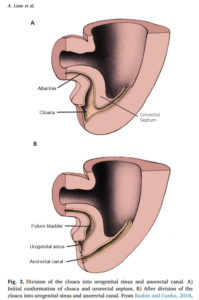urogenital sinus 尿生殖洞
- https://en.wikipedia.org/wiki/Urogenital_sinus
-
Separation of Cloaca Into Urogenital Sinus and Rectum https://app.lecturio.com/#/article/3809
- The primitive urogenital sinus arises in the fourth week of gestation from the cloaca, an epithelial chamber common to both the gastrointestinal and urogenital systems located in the pelvic region (Kromer, 1996).
- During the fifth to sixth weeks of gestation, the urorectal septum partitions the cloaca into the primitive urogenital sinus ventrally and the anorectal canal dorsally (Fig. 2).

- The bladder forms from the primitive urogenital sinus above the confluence with the Wolffian (mesonephric) ducts, which serves as the demarcation between the cranial vesicourethral canal and the caudal “urogenital sinus”.
- Unfortunately, the terminology is a bit confusing. When the cloaca is partitioned into the “primitive” urogenital sinus and the anorectal canal, the primitive urogenital sinus is in continuity with the allantois that extends cranially up the anterior body wall to end blindly in the umbilical cord.
- The cranial portion of the primitive urogenital sinus above the junction with the Wolffian (mesonephric) ducts forms the bladder. The caudal or pelvic portion of the primitive urogenital sinus in males forms the prostate, prostatic urethra, bulbourethral glands and the membranous urethra. This caudal portion of the primitive urogenital sinus is simply referred to as the “urogenital sinus”.
- Thus, one must be cognizant of this unfortunately confusing terminology.
- In females the urogenital sinus forms the urethra below the bladder neck and in the fetus also forms the sinovaginal bulbs that are confluent with the Mullerian-derived uterovaginal canal (Cunha et al., 2018; Robboy et al., 2017).
- The junction between the Mullerianderived uterovaginal canal and the urethra occurs near the future introitus (Robboy et al., 2017).
- Thus, in humans, urogenital sinus epithelium appears to form the hymen and contributes to the vaginal vestibule (Robboy et al., 2017; Cunha et al., 2018).
- The bladder and ureterovesical junction form primarily during the fourth to eighth weeks of gestation, and arise from the primitive urogenital sinus following subdivision of the cloaca.
- The human bladder is formed from the cranial portion of the primitive urogenital sinus, and collects and stores urine from the kidneys and until it can be expelled at a socially appropriate moment.
- In males the prostate develops from epithelial buds arising from the urogenital sinus (urethra) immediately below the bladder (Cunha et al., 2018).
混同しないこと:urogenital sinusは子宮にはならない
In females, the urogenital sinus develops into the urethra and vaginal vestibule, not a part of the uterus. The uterus develops from the paramesonephric (Müllerian) ducts, which fuse and connect with the urogenital sinus at the sinus tubercle. The urogenital sinus is a structure that is distinct from the uterus, and its development is separate from that of the uterus.
-
Urogenital Sinus:
During development, the urogenital sinus is a structure formed from the cloaca, which also contributes to the rectum. In females, the pelvic portion of the urogenital sinus forms the urethra and the vaginal vestibule (the area surrounding the vaginal opening).
-
Paramesonephric Ducts (Müllerian Ducts):
These ducts are a separate structure that develops alongside the urogenital sinus. In females, these ducts fuse to form the uterus and fallopian tubes.
-
Connection:
The fused paramesonephric ducts (the uterovaginal primordium) connect to the dorsal aspect of the urogenital sinus at a structure called the sinus tubercle. This connection is crucial for the development of the lower vagina.
Therefore, while the urogenital sinus and the paramesonephric ducts are closely related during development, they are distinct structures that contribute to different parts of the female reproductive and urinary systems.
尿道 Urethra の発生
The male and female urethra develop from different regions of the urogenital sinus during embryological development, leading to distinct structures and functions. In males, the urethra is longer and more complex, while in females, it is shorter and simpler.
-
Urogenital Sinus:Both male and female embryos initially have a single structure called the cloaca 排泄腔, which later divides into the urogenital sinus 尿生殖洞 (anterior) and the anal canal 肛門直腸管 (posterior).
-
Bladder 膀胱 Formation:The upper part of the urogenital sinus develops into the bladder.
-
Pelvic/Middle Part:The pelvic (middle) part of the urogenital sinus contributes to the urethra in females and the prostatic and membranous urethra in males.
-
Phallic/Caudal Part:
The phallic (caudal) part of the urogenital sinus forms part of the female reproductive tract and the spongy urethra in males.
-
Prostatic Urethra:
The prostatic urethra develops from the pelvic part of the urogenital sinus and is lined with transitional epithelium.
-
Membranous Urethra:
The membranous urethra, which passes through the pelvic floor, also develops from the pelvic part.
-
Spongy Urethra:
The spongy urethra, located within the penis, develops from the phallic part.
-
Epithelial Changes:
The epithelium lining the male urethra undergoes changes, with the prostatic urethra developing prostate buds that form the prostate gland.
- Entirely from Urogenital Sinus: The entire female urethra develops from the pelvic (middle) part of the urogenital sinus.
- Shorter and Simpler: Compared to the male urethra, the female urethra is shorter and simpler.
- Paraurethral Glands: The upper part of the female urethra also contributes to the formation of paraurethral glands, which are analogous to the prostate in males.
- External Opening: The external urethral orifice opens dorsal to the clitoris.
-
Length and Complexity:
The male urethra is significantly longer and more complex than the female urethra.
-
Epithelium:
The male urethra has different types of epithelium lining different sections (transitional, pseudostratified columnar, and stratified squamous), while the female urethra is primarily lined with transitional epithelium.
-
Associated Structures:
The male urethra is intimately associated with the prostate gland and bulbourethral glands, while the female urethra is associated with paraurethral and Bartholin’s glands.
-
Developmental Origin:While both arise from the urogenital sinus, the specific regions and subsequent development differ, leading to the distinct structures.
(Gooogle 検索結果 AI Overview)
参考書
- Qシリーズ新発生学 97ページ Q58 膀胱の発生と先天異常